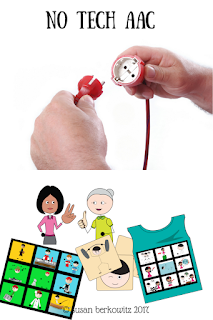Before all children begin speaking they learn to use communicative gestures. Some of these gestures continue to be extensions or variations on other actions; for example pointing is a more refined version or reaching. Some gestures are more formal and some, like signs, only become communicative when a group of people assign a consistent meaning to them.
In addition to gestures, a variety of body movements can be communicative. Facial expressions are very communicative, as are shaking and nodding our heads, shrugging our shoulders and turning away. We learn to hold up objects for others to see, wave hello and good-bye, hold out two items to make a choice.
Sometimes in AAC intervention we forget that we all use gestures to communicate, and the gestures and communicative body actions of the nonverbal individual continue to be valuable communication tools. Too often those gestures are extinguished or ignored in favor of “more appropriate” communication. While actions that are disruptive or destructive certainly want to be eliminated, many gestures continue to be appropriate for communication, and should not necessarily be replaced by more formal symbolic communication.
The truly no tech AAC system is sign language.
Sign language was used with populations other than the deaf in the 1960s through the 1980s as research found that many persons with developmental disabilities and autism were able to learn to use signs more easily than speech.
It must be noted, however, that what was being taught to these individuals were individual signs; not sign language per se. There are many more subtle hand positions and other cues that go into sign language that are not present in the teaching of signs to other populations.
Additionally, most of the individuals with developmental disabilities and autism using signs use poorly articulated signs as well as idiosyncratic signs.
Lack of comprehension by others in the community is a problem for communication via sign; often even members of the signing community do not understand the poorly articulated signs these individuals use.
©smarty symbols; all rights reserved
Stephen Calculator devised a system of Enhanced Natural Gestures (ENGs). These are natural intentional gestures that may already be in the individual’s repertoire, or can be easily taught, and that represent what they mean so are easily understood by others.
Unlike contact gestures, such as taking objects from partners or pulling partners toward preferred activities, ENGs do not require physical contact with items or persons and are readily understood by others in context.
They have been found to be easily taught to and effectively used by individuals with Angelman’s Syndrome. ENGs are motor behaviors that are already used by the individual or can be easily taught, and are understood by an observer. For example, an individual might be taught to hold a cup to his mouth to indicate a desire for a drink.
No tech is also considered to include object-based systems, as well as paper based systems that may or may not be created with a computer, using letters, words, and/or picture symbols. Examples can include:
1. Object boards (with or without symbols or text). Object boards are sometimes used for individuals who relate better to concrete objects, or those who have severe vision impairments, or who are deaf-blind, and who have difficulty understanding the symbolic nature of pictures. This often limits those students’ available vocabulary and restricts their access to a variety of communicative intents.
2. Single pictures (or photographs) that are good for labeling items in the environment or for making simple requests. Even without technological solutions and equipment there is a lot that can be done in classrooms for students who need AAC (but might not yet have it) using pictures taken from software, websites, magazines, or other educational sources.
Pictures/symbols can be used to teach categorization and to define and describe. They can be used to learn and sort words/symbols by parts of speech. They can be used to teach phonological awareness skills for literacy learners; such as initial and final sounds, word families and rhyming words. They can be used to create word webs to teach vocabulary skills and help to strengthen the connections needed for finding vocabulary within some AAC systems. You can also teach prepositional concepts and the concept of same and different.
Pictures or symbols can be used for playing a variety of thematic “Guess Who” games similar to the popular Milton-Bradley game (to build describing skills and questioning skills), and to create language-based cards for a variety of card games.
Use single pictures to teach a single core vocabulary word. Use 2 pictures to teach a yes/no response or to teach choice-making.
Next week, we'll talk more about communication books and boards.
Until then.... Keep on Talking!





Great ideas for getting students started with communication skills! Linda
ReplyDeleteSometimes we need to remember that it's not about the technology; it's about what the individual needs. Thanks for reading.
ReplyDeleteRarely a day goes by in school when I'm don't sign to someone. It is my go to for directions. Quick and easy.
ReplyDeleteYep, signs are quick, easy, and always with you.
Delete